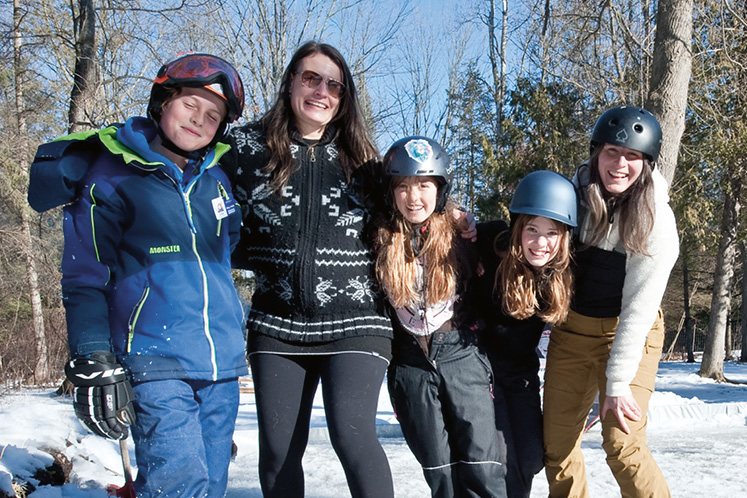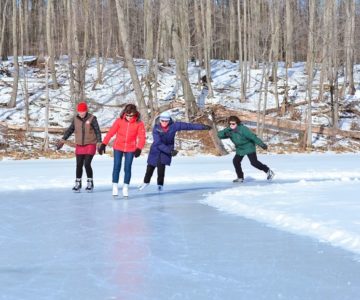Sheet of Dreams – How Backyard Rinks Are a True Labour of Love
People don’t just ‘build rinks’, they build memories of embracing the winter and playing together, as a family.
The backyard rink of my fond and unfading memory was likely much smaller and more crudely fashioned than the one I recall. In reality it would have been little more than a parlour-sized rectangle, bounded by scavenged 2x4s backed by snowbanks and overhung by the bare branches of birches and maples. For me, it was heaven. Winters lasted forever.
That backyard Scarborough rink was where I learned to skate, taught by immigrant (Australia and England) parents who had never owned ice skates. It was where new Christmas hockey sticks first touched a puck. It was where neighbourhood friends convened. It was where I dreamed.
To my 10-year-old self, it was a shining Sheet of Dreams, ranking just short of Maple Leaf Gardens, where I was surely bound, one day, to score the Game 7, Stanley Cup-winning goal for the Toronto Maple Leafs. In overtime.
A sole black and white photo from those days shows a muffled and gap-toothed boy standing alongside sister and neighbour kids, gripping a stick and grinning with delusions of hockey grandeur.
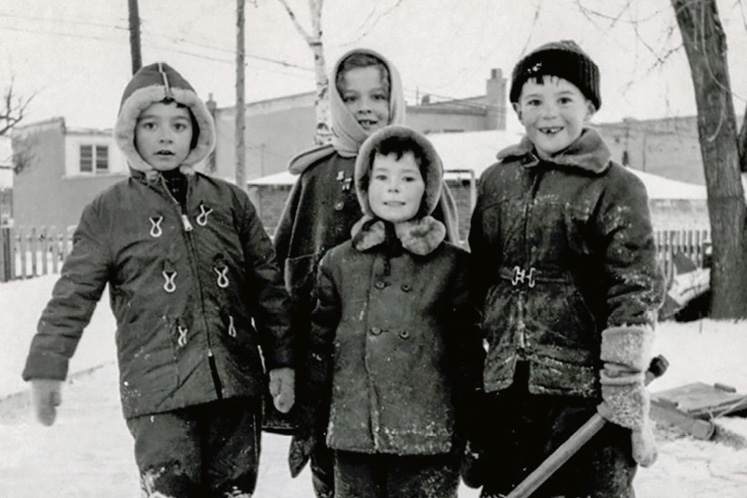
Writer Anthony Jenkins (far right) as an exuberant, gap-toothed youngster taking on the hockey world in the 1950s, with his sister and two neighbourhood friends in tow.
When I was signed up for “organized” hockey (my first Tyke team was named for sponsor Baby Bunny Nuts, a hot nut vending machine firm), I quickly learned that on someone else’s rink – anyone else’s rink – I wasn’t very good. That has never changed. Six decades later I’m still not very good, and I’m slower now in my mediocrity.
But on that backyard rink, playing neighbours, and the big sisters of neighbours, I was always Dick Duff, my favourite Leaf left winger, and the commentary in my head of my dekes, dodges, rushes and goals was by Foster Hewitt.
The prosaic never entered my childhood mind. Our rink just “was,” from mid-November until April. I never questioned the how or the why.
Brief strobes of memory are all that illuminate that unquestioning selfishness. My mother, who had never seen snow as a child, backlit by the porch light and hauling steaming pails of hot water out to the trampled snow between her spring tulip beds. My father, a, spooky silhouette in galoshes under a canopy of stars, casting arcs of spray back and forth while I watched in PJs from a kitchen window. I remember frozen stiff mitts laid on a radiator to thaw as I was put to bed.
Climate change, lethargy, and uninterested daughters changed the backyard rink when I became a parent. I made a couple of half-hearted attempts at a suburban Toronto backyard rink. I produced slush, blue fingertips and more disinterest than disappointment. The backyard rink has become a wistful memory.
‘The Whole Backyard Was a Rink’
Memories of frozen fingertips are more recent for Geneviève Dooley, who shares a home on an acre in Hockley Village with two kids, three dogs, and three joined lengths of garden hose. Remembering frigid February nights outside at the end of that hose, she can’t help but laugh as I talk to her on a balmy August afternoon.
“I’ll be out there thinking, ‘I’ve come this far, put all the effort in, I’m going to continue.’ We’ve probably had many good days on the rink by then. I’ll let it run its course … but I’ll also be there with freezing fingers, thinking, ‘Why? Why am I doing this?’”
Geneviève’s “why” reveals itself as a lifelong love of the outdoors, of winter, of family and “being Canadian.” Geneviève and her sisters were raised in Brampton. Their dad played hockey. “All winter – the winters were longer and colder back then – the whole backyard was a rink. The sliding glass doors opened and you stepped out onto the rink. Our dad would skate with us. We’d skate and skate and take a break and Mom would bring hot chocolate out. The rink brought everyone together. It still does.”
The “how” of building and maintaining her 30×15-foot backyard rink is simple and straightforward, as long as the weather co-operates. Increasingly, as our planet warms, it does not. On a long back lawn in a kid-friendly yard cleared of summer detritus (bikes, balls, wagons, trampolines), a low wood frame is built. Geneviève’s dad volunteers to help with that. Around Christmas, she’ll work the hose, flooding the ground in layers, slowly, night by chilly night.
“By early in January, if the weather is good, you can get on it,” she says. Skaters include herself; her kids, Zavier and Maxine; dogs Bo, Daisy and Paul (who regularly ignore a No Dogs on Ice rule); neighbourhood kids and, occasionally, her father and visiting friends.
Geneviève estimates she’ll spend 30 minutes every night (always nights because it’s colder – better for making ice and numbing fingers) shovelling snow and spraying water. Additional time is needed if freezing rain has made the ice bumpy and it requires more flooding, or if there is a major snowfall – when the kids will help shovel the rink clear.
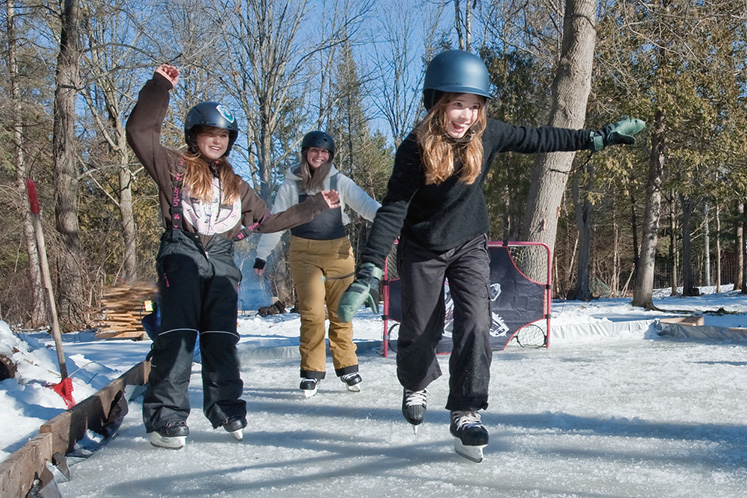
Maxine Dooley Saxty (left) and her chum Mavis Marr (right) race ahead of Mavis’s mom, Jessica Harrower, on the rink Geneviève Dooley built in the family’s backyard in Hockley Village.
“Then I have to bring the hoses in. They’ll freeze in the garage. I bring them inside at night and coil them in a big container to thaw out. Sometimes I forget and everything is frozen. I have to have it into the shower to thaw, then bring it out again!” she laughs. “I forgot. Add extra time for that!”
But, surveying a low swath of lawn where the rink once was – and will be, she says, “It has been worth it. I build it for me, and for them. The rink got a lot of use during Covid. You were limited in doing things. My kids spent a lot of time outside. It got us through some dark times. “I remember when I was little, the rink my dad built, and I carry that memory forward as a rink for my kids. Hopefully, they will remember too.”
Hockey Day in Hockley
Tom Darlow isn’t nuts – I asked – but he is quietly proud. “More people than you think up here have rinks, but I don’t think my level is common. When I tell people where I live – ‘I’m at the corner of Hockley and Airport roads, I’m the guy with the ice rink’ – they say ‘You’re a landmark!’ Everyone just knows!”
Tom’s rink (the name “Darlow Gardens” has been suggested) has been an evolving icon in Hockley for 15 winters. Indeed, in December you could hit the intersection of Hockley and Airport roads with a slap shot from the 40×90-foot rink that comprises most of the Darlows’ front yard (wife, Julie, is a proud supporter and collaborator). Unlike me, Geneviève Dooley, and almost everyone else, Tom Darlow, facility manager for the Town of Caledon, doesn’t dread being outside, spraying water under the stars in punishing cold.
“I just love it! It’s super cold, your jacket is crackling, there is a light snow coming down … a lot of Canadians lock themselves in the house. They don’t enjoy the winter. I’m thinking, ‘I can’t believe people are inside watching TV when they could be doing this!’”
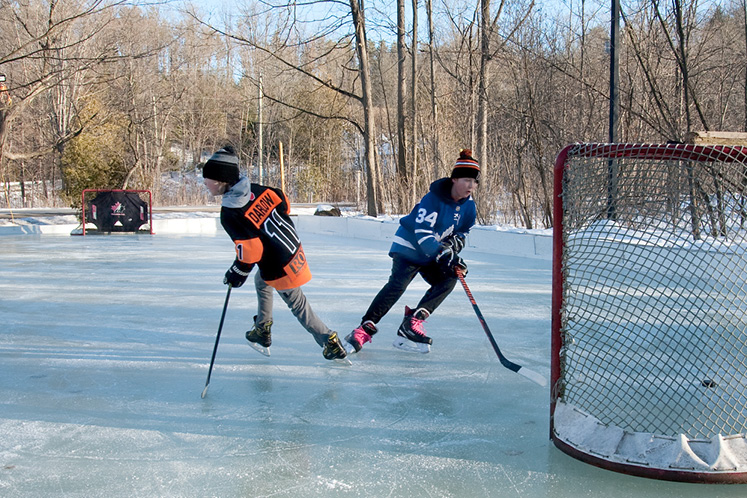
The Darlow boys, Ryan (left) and Jake, practise their moves on the backyard rink their dad, Tom, built.
Unlike me, Tom had no idealized ice rink or NHL dreams in his childhood. He grew up in Bolton and didn’t play hockey until university, where he trained as an engineer and met his engineer-to-be wife. “I’ve always been fascinated with the idea of building things,” he says. “I’ve always been an outdoor person, a winter person. When I was a kid, I used to put water down on our back deck and slide around in boots. We’d build snow forts and put water on for bum slides. You could say I’ve always been interested in freezing stuff and playing outdoors. I guess my medium has changed.”
Though you’d not notice unless you were an ant, the Darlows’ large lawn fronting a three-quarter-acre lot slopes slightly. It’s 20 inches higher on one side than on the other. In summer, on the high side, half-hidden in the brush below a line of maples, lies Tom’s stacked “board system,” which is engineer-speak for a catalogued and numbered pile of white-painted rink boundary boards, developed and refined over the years and ranging in height from 18 to 36 inches.
Their assembly in December, before the first snow, is a convivial, communal affair. Friends, engineers, tradespeople and peers – “guys who come out and play” – show up at noon and have the boards assembled, erected and draped with a massive tarp by early evening. Dinner, drinks and poker follow. “We’re all proud of what we’ve done. It is a party everyone looks forward to.”
Water is brought in from the Nottawasaga River, which flows beyond the woods behind the Darlows’ property, pumped through 600 feet of used, donated fire hose passing through, with permission, a neighbour’s property. It can take 16 hours or more to fill the tarp-draped rectangular structure to a depth of 22 inches (only three inches deep on the high side). “You can get a nice thin layer of ice within a day or two. To be able to walk on it takes 10 days with temperatures below zero.”
It’s often below zero – well below, notes Julie – in the wee hours when duvets beckon and frostbite lurks. “He’ll be out at 3 a.m. It’s cold as hell and he’ll take advantage of that, especially at the start when you are trying to build thickness as fast as you can.”
Tom smiles at the thought. “Once the base freezes, I flood it by hand like everybody in the beginning, back and forth with a hose until the first week of January, waiting for the ice to get thick enough. The big thing is getting the snow off. Snow insulates. It wrecks the ice. You have to get it off, then flood. “Then you can put the Zamboni on.”
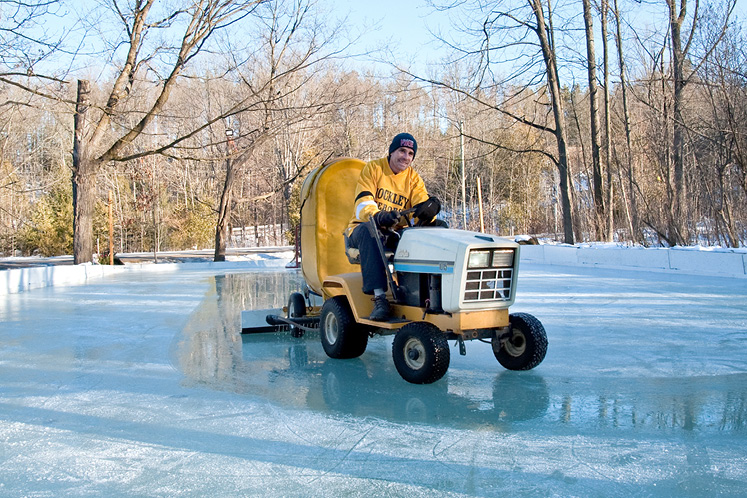
Tom Darlow astride his “Zamboni” – a contraption of his own design – on his outdoor ice rink in Hockley Valley.
A Zamboni? Well, call it an ice-resurfacing contraption – ingenious, home-engineered and effective. It comprises a lawn tractor hauling one-third of a reconfigured home heating oil tank filled with hot water (yes, hot water freezes faster and harder than cold) and fitted underneath with a valve system and dispenser. “It’s simple and it works,” says Tom.
One year, due to impatience or imprudence, the machine broke through the ice. Getting it out was a family affair.
Zamboni-ing the rink is a 10-minute operation, once around, going back and forth, hot water steaming, every night. “Once I have a solid base, I’m not trying to build ice, just retain ice.”
Tom estimates he averages 10 hours a week on rink maintenance: shovelling, flooding, resurfacing. Costs for an annual tarp replacement, gas, lights (installed on poles and in the trees), hot water – with love and labour free – come to about $1,000 a season.
Climate change is not in doubt for those with outdoor rinks. The ice forms later in the year and deteriorates earlier. Tom remains positive, for now. A vague “eventually” is a word he will allow for their extinction.
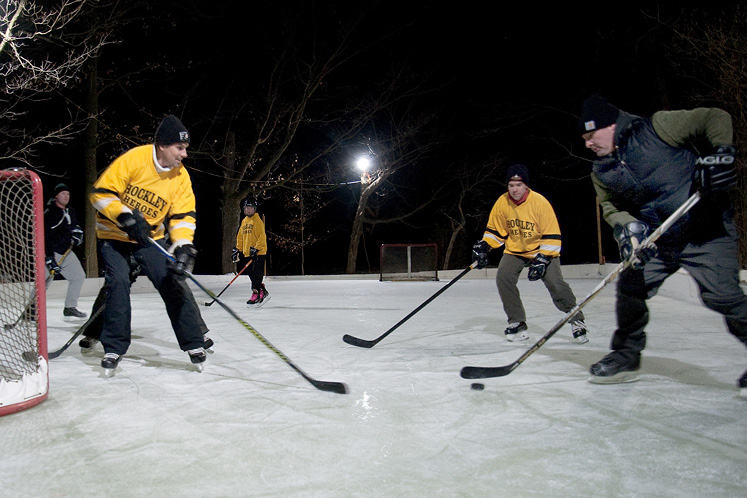
A friendly game of shinny in Hockley. From left rear to right, Ian Toddhunter, Tom Darlow, Jake Darlow, Grant Scholes and Kevin Gibbs.
“Overall, the time we spend on the rink from one year to the other is pretty similar. The start date and the end date may change. Sometimes a week comes when it’s too slushy and you can’t be on it. You watch the weather. Orangeville is probably three or four degrees colder than Toronto, not scientifically, but roughly. The average temperature here has risen, but in winter it is still below zero.”
The Darlow family rink is well used and well enjoyed. Tom and Julie’s hockey-playing sons, Jake and Ryan, learned to skate and play out there. Many other people’s kids did too. Friends and Tom’s men’s pond hockey team, Hockley Heroes, play and practise there. And annually, in February, until Covid caused a halt, self-proclaimed “Hockey Day in Hockley” happens. Friends and extended family come out, skate or learn to skate, play shinny, enjoy the ice and one another.
Is the cold, time, effort and expense of building his rink worth it? Tom Darlow, engineer, lover of the outdoors, father, doesn’t hesitate. “The project itself is worth it. Anytime people are skating on it just makes it better.”
Related Stories
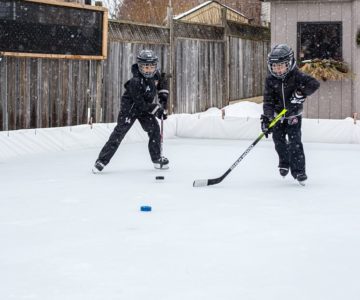
Home Game
Nov 24, 2020 | | At Home in the HillsA backyard rink is just one of the deft holiday moves NHL linesman Shandor Alphonso and his wife, Jacelyn, make for their young boys at home.

